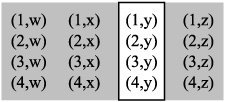Correspondence Between Sets
To take the examination of ordered pairs into slightly more detail, suppose that you create two sets, A and B, and you assign them elements as follows:
A = {1, 2, 3, 4} B = {w,x, y, z}
You then examine the correspondence between the two sets and create the following ordered pairs:
(1, w) (1, x) (1, y) (1, z)
(2, w) (2, x) (2, y) (2, z)
(3, w) (3, x) (3, y) (3, z)
(4, w) (4, x) (4, y) (4, z)
To create these pairs, you begin with the first element from set A and pair it with the first element of set B. You then again draw on the first element of set A and go to the second element of set B. You continue this way until you have paired the first element of set A with all the elements of set B. You then use the second element of set A and proceed as before, pairing it with each element of set B. You continue this activity until you have created all possible ordered pairs that can pertain between sets A and B.
This correspondence of elements in the two sets is known as the Cartesian product of the two sets. You represent a Cartesian product as A × B. The × in this case represents the exploration of the way the elements of the two sets relate to each other. The result of the exploration is called the product of the two sets.
When you proceed in this manner, you begin with a specific pattern of creating a correspondence—or product. At the same time, after you have created the Cartesian product, you can continue on to discover certain subsets. For example, consider the subset of all ordered pairs that contain 1 as a first element. On the other hand, as Figure 4.7 illustrates, you might also describe a subset that consists of the pairs with y as a second element.
Figure 4.7. If you examine the pairs in a Cartesian product, you can discern subsets.

